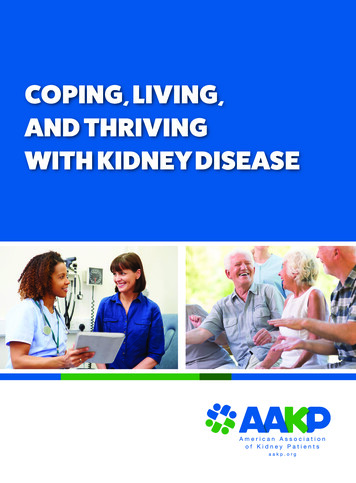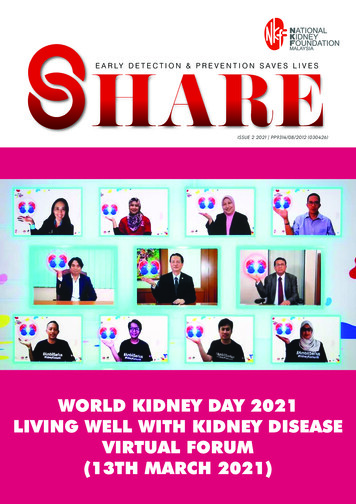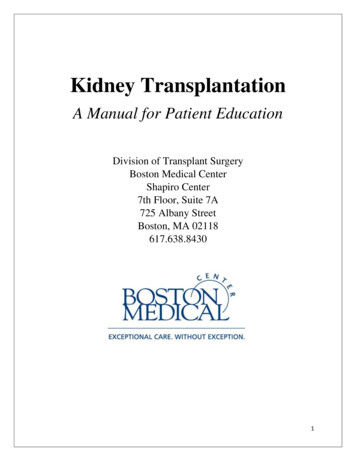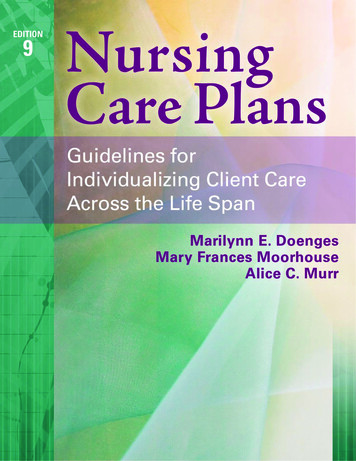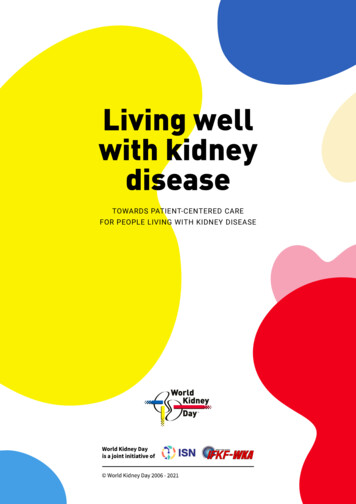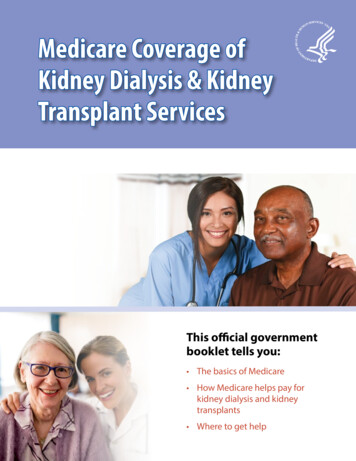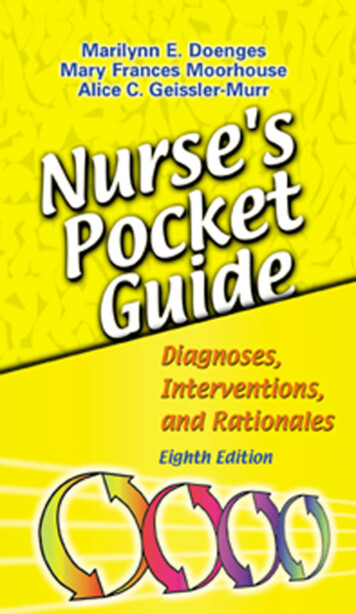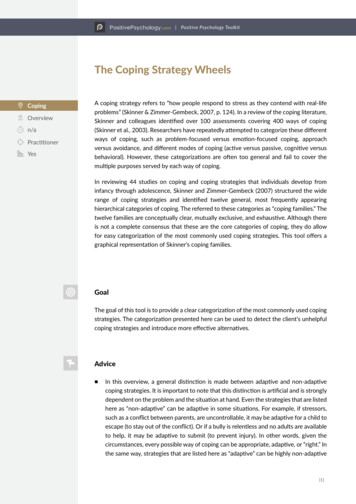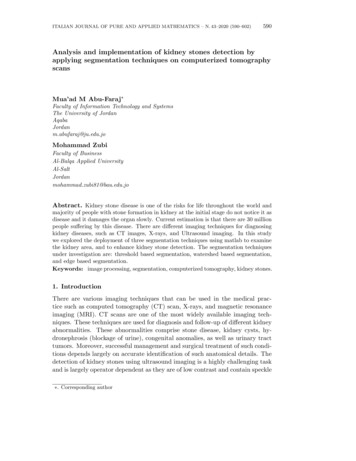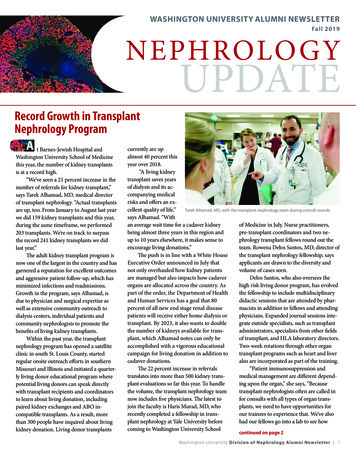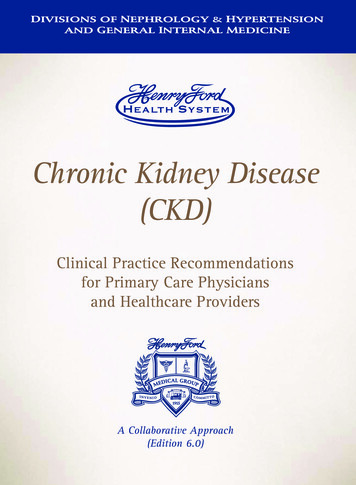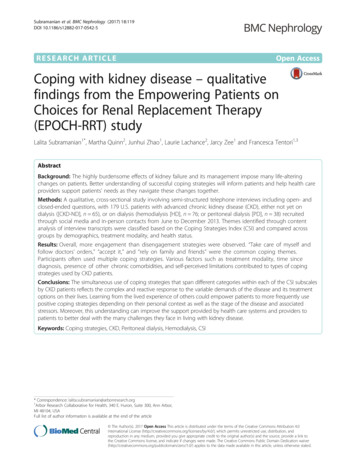
Transcription
Subramanian et al. BMC Nephrology (2017) 18:119DOI 10.1186/s12882-017-0542-5RESEARCH ARTICLEOpen AccessCoping with kidney disease – qualitativefindings from the Empowering Patients onChoices for Renal Replacement Therapy(EPOCH-RRT) studyLalita Subramanian1*, Martha Quinn2, Junhui Zhao1, Laurie Lachance2, Jarcy Zee1 and Francesca Tentori1,3AbstractBackground: The highly burdensome effects of kidney failure and its management impose many life-alteringchanges on patients. Better understanding of successful coping strategies will inform patients and help health careproviders support patients’ needs as they navigate these changes together.Methods: A qualitative, cross-sectional study involving semi-structured telephone interviews including open- andclosed-ended questions, with 179 U.S. patients with advanced chronic kidney disease (CKD), either not yet ondialysis ([CKD-ND], n 65), or on dialysis (hemodialysis [HD], n 76; or peritoneal dialysis [PD], n 38) recruitedthrough social media and in-person contacts from June to December 2013. Themes identified through contentanalysis of interview transcripts were classified based on the Coping Strategies Index (CSI) and compared acrossgroups by demographics, treatment modality, and health status.Results: Overall, more engagement than disengagement strategies were observed. “Take care of myself andfollow doctors’ orders,” “accept it,” and “rely on family and friends” were the common coping themes.Participants often used multiple coping strategies. Various factors such as treatment modality, time sincediagnosis, presence of other chronic comorbidities, and self-perceived limitations contributed to types of copingstrategies used by CKD patients.Conclusions: The simultaneous use of coping strategies that span different categories within each of the CSI subscalesby CKD patients reflects the complex and reactive response to the variable demands of the disease and its treatmentoptions on their lives. Learning from the lived experience of others could empower patients to more frequently usepositive coping strategies depending on their personal context as well as the stage of the disease and associatedstressors. Moreover, this understanding can improve the support provided by health care systems and providers topatients to better deal with the many challenges they face in living with kidney disease.Keywords: Coping strategies, CKD, Peritoneal dialysis, Hemodialysis, CSI* Correspondence: lalita.subramanian@arborresearch.org1Arbor Research Collaborative for Health, 340 E. Huron, Suite 300, Ann Arbor,MI 48104, USAFull list of author information is available at the end of the article The Author(s). 2017 Open Access This article is distributed under the terms of the Creative Commons Attribution 4.0International License (http://creativecommons.org/licenses/by/4.0/), which permits unrestricted use, distribution, andreproduction in any medium, provided you give appropriate credit to the original author(s) and the source, provide a link tothe Creative Commons license, and indicate if changes were made. The Creative Commons Public Domain Dedication o/1.0/) applies to the data made available in this article, unless otherwise stated.
Subramanian et al. BMC Nephrology (2017) 18:119BackgroundAt the end of 2013, there were 655,435 people in theUnited States with kidney failure, an increase of 68%since 2000 [1]. Treatment options for kidney failure include kidney transplantation (2.6% of incident patientsin 2013) and dialysis (97.2%) [1]. Chronic kidney disease(CKD) requires a multi-faceted treatment plan that impacts many aspects of everyday life, including diet, fluidintake, time available for leisure activities, and selfmanagement of multiple therapeutic interventions andmedications [2]. CKD patients often also have to dealwith several other chronic comorbidities, especially diabetes, hypertension, and cardiovascular diseases [3, 4].These patients also face the challenge and burden of theintrusive and irreversible consequences of kidney failureon their physical and mental health, as well as on theirquality of life, including the impact on their family, lifestyle, relationships, and employment [5, 6].The clinical effects of kidney failure include fluid retention, anemia, elevated blood pressure, bone and mineral disorders, accelerated cardiovascular disease, andsexual dysfunction [7, 8]. The effects of kidney failureand its treatment, the lack of a cure, and the impact oftreatment options on lifestyle and well-being contributeto a sustained source of stressors in the lives of these patients [2].While CKD onset is most common later in life(mean age 62.5 years in the United States [1]), somepatients develop kidney failure in childhood, resultingin a lifetime of managing the disease and its impacton their lives.Coping is a response mechanism used to regulate theeffect of different types of life stressors on physiologicalresponses [9]. There is some evidence that coping strategies employed by individuals in dealing with chronicdiseases could help explain some differences in their disease survival rates, as well as their ability to adjust to thechallenges experienced while living with chronic diseases[10]. For example, a recent study suggests that optimismPage 2 of 10may have a direct physiological effect on the neuroendocrine system and on immune responses, while also having an indirect effect on health outcomes by promotingprotective health behaviors, adaptive coping strategies,and enhancing positive mood [11]. A qualitative study ofThai CKD patients in California suggests that spiritualityor religiosity is an important means of coping for thesepatients [12].Tobin et al. proposed that there is a hierarchical structure to coping strategies (Fig. 1) [13]. These are described as the primary, secondary, and tertiary subscalesin the Coping Strategies Inventory (CSI) that has sincebeen used to develop patient-reported outcome measures for coping [9, 14]. At the primary level, this factorstructure includes eight coping strategies [13]. At thesecondary level, each of the primary categories is classified into either problem-focused coping or emotionfocused coping. Problem-focused coping relates to actions that are taken to alter the source of stress, whileemotion-focused coping addresses the emotional distressor the emotional response associated with the source ofstress [15]. Coping efforts are categorized at the tertiarylevel as either engagement or disengagement strategies.Engagement involves confronting stressors and is believed to reduce the impact of long-term physiologicaland psychological stress. Disengagement strategies relyon avoiding undesirable stressors which often haveshort-term benefits, but might cause longer-term problems. The CSI questionnaires developed based on thisframework are widely used to assess coping in variouscontexts [9, 16–20]. A prior analysis of CSI data from aninternational cohort of HD patients found that in the USengagement strategies were used more often than disengagement strategies. However, PD and CKD patientsmay face different sets of challenges. Close-ended surveyresponses are valuable but do not provide the richnessof information, such as how these coping strategies arebeing applied in the context of the challenges faced bythese patients. Additionally, survey questions couldFig. 1 Schematic of the classification of primary, secondary and tertiary subscales within the Coping Strategies Index. *This primary subscale wasnot identified in our data
Subramanian et al. BMC Nephrology (2017) 18:119Page 3 of 10potentially prompt a response with no opportunity toqualify it.The Empowering Patients on Choices for Renal Replacement Therapy (EPOCH-RRT) Study, supported inpart by the Patient-Centered Outcomes Research Institute(PCORI), was designed to empower kidney disease patients by providing relevant information that was systematically derived from other patients’ experiences topromote shared decision making on dialysis modalities.The primary aim of the EPOCH-RRT study was to develop a dialysis decision aid, that is now publicly available(www.choosingdialysis.org). The current work leveragesdata collected during EPOCH-RRT and describes the results of the analysis through the lens of the CSI frameworkto investigate how patients cope with kidney disease so asto inform health care professionals and to support patientsin managing their chronic conditions.the time of the interviews, 65 participants were CKD-ND,77 were on HD (65 in-center and 12 home), and 38 wereon PD. All study procedures were approved by local institutional review boards (Ethical and Independent ReviewServices E&I #13016, Henry Ford Health Systems IRB#8144, University of Michigan IRBMED HUM00073058),as appropriate.MethodsData analysis methodsStudy designOf the 180 interviews, 179 people had responded to thequestion, “How do you cope or deal with your kidneyproblems?” All responses were manually coded by twoindependent coders to identify common themes usingcontent analysis. Coders discussed and resolved discrepancies to achieve consensus. During the analysis, a codebook of theme categories was created, shared amongcoders, and added to as new themes emerged directlyfrom patient responses. Coders conferred multiple timesregarding patterns and themes until no new themes wereidentified and saturation was reached. Each theme wascounted only once for each individual even if it wasidentified in more than one context. Some themes wereidentified based on the tone and attitude underlying theresponse rather than the specific quote, e.g., in a few (23) cases where the respondent joked about their condition, the coders agreed, based on the larger context ofthe response, that these patients were using humor tocope with their disease. Responses were entered intoNVivo 10 and common themes were identified across allpatients. Once consensus was reached, the final list of 38themes was classified based on the CSI framework intoprimary subscales, from which the secondary and tertiary scales were derived. Similarly, themes were generated from all the responses from the same group ofpatients to the question, “Now I’d like you to thinkabout your kidney problems in general, what bothersyou most about having kidney disease?”The EPOCH-RRT study was developed to understandthe decision making process in selecting treatment options from the perspective of the CKD patient. It involved a collaborative approach between academicresearchers and an advisory panel (AP) of nine patientsand family members, as well as health care professionals(nephrologists, social workers). Kidney disease patientsparticipating on the AP co-designed and pilot-tested theinterview protocols [21], met periodically throughout thestudy to provide input on the analysis, and helped to interpret findings as it related to the development of thedecision aid. Protocols used a mixed-methods approachcomprising primarily open-ended and some closedended questions, including yes/no, categorical, andLikert-type scales (1–10). Participant information ondemographics, clinical history, and patients’ perceptionof their health status were also collected at the time ofthe interview. Interviewers were trained and followedthe interview protocol, in both content and sequence, toensure uniform data collection.Recruitment of participantsInclusion criteria were: (a) age 18; (b) eGFR 25 mL/min/1.73 m2 or on dialysis (HD or PD) for at least threemonths. Individuals who had previously had a kidneytransplant were not excluded. A total of 181 interviewswere conducted and 180 were included in this analysis;one interview was excluded because the participant wasthe only one receiving care outside of the U.S., where clinical practices, social, and cultural factors may be different.Participants were recruited both through nationwide weband social media (Facebook) outreach and in-person bystudy team social workers in Southeast Michigan renalclinics and dialysis units, as described previously [21]. AtData collectionThe semi-structured interview protocol included questions and probes on experience living with kidney disease,aspects they found most bothersome, how they dealt orcoped with their problems, and their decision making involvement with treatment options [21]. Between June andDecember 2013, two trained interviewers conducted telephone interviews that were digitally recorded and transcribed. Each interview lasted 30-45 min.ResultsDemographicsCKD-ND patients tended to be older (mean ages inCKD-ND 63.4, HD 55.8, PD 50.4), had more femalerespondents, were more frequently diagnosed within thelast year, more often felt they were in poor health, more
Subramanian et al. BMC Nephrology (2017) 18:119Page 4 of 10frequently expressed limitations in daily life, and moreoften had three or more chronic conditions compared toHD and PD patients. More CKD-ND and HD patientswere recruited in the study than PD patients (Table 1).Some had prior dialysis experience different fromcurrent treatment status.Bothersome aspects of a kidney disease diagnosisThe most commonly eluded to bothersome aspect ofhaving kidney disease was the time spent on dialysis.Table 1 Characteristics of participants by treatment modalityand attributes at the time of interviewsAttributesCKD-NDHDPDAllNumber of patients, N657638179 ale66.247.452.655.353.850.760.053.7Age, years, %Gender, %aRace/Ethnicity , %Caucasian/WhiteAfrican lysis was perceived as a limitation by those alreadyon dialysis and dreaded by the CKD-ND patients. OneHD patient said, “The time spent there [dialysis center].I’m not excited about those sixteen hours; I could use ‘emdoing something else.” Patients were also bothered bydiet restrictions, inability to travel freely, the lifelong, incurable, and fatal aspect of the diagnosis as well as theinability to control disease progression. For example,one participant said, “I think renal patients probablyhave one of the strictest diets that exist most of the stuffI like, you know, I’m not supposed to eat.” Meanwhile, foranother patient, what bothered them most was, “So it’sjust the- the fact that this thing won’t go away, it’s mywhole life, it’s always there.” Several patients alluded tothe wait for a kidney transplant, as one patient declaredwhat was most bothersome was, “waiting for so long, onthe list that I’m on, for a kidney.” Patients were troubledby aspects of the disease that impacted their daily lifelike employment and independence; some were botheredabout not having taken care of themselves prior to thediagnosis, loss of control, limited treatment options,symptoms, financial concerns, physical appearance, andsocial acceptance. One participant described it as, “something that bothers me is that my family doesn’t understand and I can’t explain it to them in words becausethere are none to describe each day’s random changes tothe condition.” Responses to this question clearly indicate that kidney disease has a serious impact on the lifeof patients and these patients have to deal with manylong-term physical, psychosocial, and financial stresses.When did you first find out you had kidney problems, %Within the past yr16.95.30.08.4Coping themes and classification of themes1-5 years ago30.829.331.630.36-10 year ago18.512.021.116.310 yrs ago26.237.334.232.6Since birth or childhood7.716.013.212.4Excellent4.65.35.35.0Very .828.015.833.7The distribution of coping themes across HD, PD, andCKD-ND patients is described in Fig. 2. Seventeen ofthe themes were common to all three sub-groups; however, each sub-group also had some distinct copingthemes. For example, the theme “Compartmentalize andonly deal with what I have to at that time” and “Perspective - realize it could it be worse” were two themes thatwere only identified among PD patients. A PD patientdealing with three or more chronic conditions said, “Ithink I compartmentalize. I deal with what has to bedealt with, and then push it aside, when I’ve dealt withit. So it doesn’t interfere with my day-to-day life.”“Helping others with kidney disease,” “staying preoccupied during dialysis,” and “be aware of your own limits”were common themes that were identified exclusivelyamong HD patients. There were six themes identifiedonly among CKD-ND patients, and each was unique toa particular patient. All the themes were then classifiedbased on the CSI framework. None of the themes fitunder self-criticism, and therefore only seven primarysubscales were used. The most frequently identifiedthemes for each of the primary subscales and examplesSelf-rated health status, %Limitations in daily activities, %Number of Other Chronic Conditions, %a09.26.62.66.7116.915.834.220.1221.532.921.126.33 or more52.344.742.146.91 HD and 3 PD patients did not provide race/ethnicity information
Subramanian et al. BMC Nephrology (2017) 18:119Page 5 of 10of quotes for these themes are described in Table 2.“Take care of myself and follow doctors’ orders,” “acceptit,” and “rely on family and friends” were the most frequently used coping strategies overall. Individuals sometimes used multiple coping themes that were either inthe same primary subscale or across different primarysubscales. For example, a female CKD-ND patient whenasked how she coped said, “I take a Celexa every dayand I try not to take Xanax. I have point- oh-point-twofive, I think it is Xanax and she said try to keep it to notmore than two a day. And I try to spread it out over theweek that I only take about three times And I have godand I have a fantastic family. If it wasn’t for that I don’tknow what I would do.”Primary subscales by demographicsFig. 2 Number of coping themes identified by patients, classified bytreatment modality – hemodialysis (HD), peritoneal dialysis (PD) andpre-dialysis (CKD-ND)Table 3 describes the percentage of individuals in different demographic groups relying on coping strategies(themes) classified based on the CSI framework. A decrease in percentage of individuals using social supportto cope with their kidney disease was observed with increasing age. Within this primary subscale, those lessthan 45 years most frequently used “rely on family andTable 2 Classification of emergent themes from data to the CSI frameworkSample quotesRepresentative themesPrimarySecondary Tertiary“I like to crack jokes make people laugh when I gothere for 4 h I got a whole new audience to impress!”Keep my sense of humor or usehumorExpress emotionEFE“If I didn’t have my wife, I probly [sic] wouldn’t bealive I’m coping because of her.”“I have a lot of family around me so that helps. Youknow, they’re always there for me.”Rely on family or friends for supportand encouragementSocial support“If I didn’t have God, I know I wouldn’t be able to dealwith it.”“Well, I’ve gotten more spiritual now attendingchurch more.”Spiritual or pray“I have to accept it, for what it is. I just, accept it andtry to live a productive life.”Accept it“I can still try to do the best that I can right now.”Do the best I can“You’ve got to keep your access sites clean and I’veworked pretty hard at that And I try not to get coldsand I’ve tried to stay healthy”Take care of myself and followdoctor’s orders (e.g. medications,diet, fluid, rest)“I like hobbies .[listed several hobbies], I learned tocrochet”“I still want to build a company, I still want to makemoney I could retire but it’s the last thing on mymind.”Stay active and busy with hobbies orwork“I have to be very careful, like I don’t use my cane Idon’t let them see how vulnerable I am.”Protect myself and not let others seehow vulnerable I amSocial withdrawal“I don’t think of it in terms of kidney problems, Isuspect I probably should”Ignore itProblem avoidance PFD“It’s not a problem I don’t see where I have to cope, Ijust go through life.”Feel fine, don’t need a way to cope“I hope to get better the doctor says that itwouldn’t get any better so I guess the dialysis is theway to keep you alive.”Resigned but hope it will get betterCognitiverestructuringENGAGEMENTPFEProblem solvingWishful thinkingEFDDISENGAGEMENT
Subramanian et al. BMC Nephrology (2017) 18:119Page 6 of 10Table 3 Relative use of coping strategies (themes) classified within primary subscales and by age, gender, and daryPrimaryAge, %Gender, %Race/ethnicity, % 4545-5960-7475 MaleFemaleWhiteBlackOtherN 48N 47N 50N 34N 80N 99N 94N 70N 11EFEExpress emotion6261266749Social support463626122834244036PFECognitive restructuring50a51a56a414555a4457a64aProblem solving191516322019221645EFDSocial withdrawal000301010PFDProblem avoidance35534056a49a4256a3327Wishful thinking020311010Note: Four people are missing race/ethnicity information.a-Most frequently used primary subscale within each subgroupfriends” and “spiritual/pray” themes. For example, ayoung male on PD said, “my faith has helped me toaccept things.” More women used social support (34%),with the biggest difference being in the “talk with othersabout my feelings” theme, and cognitive restructuring(55%) than men (28% and 45%, respectively). Meanwhile,a slightly higher percentage of men (49% vs. 42%)resorted to problem avoidance, typically with the “ignoreit” theme, than women. A greater percentage of blackpatients cited cognitive restructuring strategies (57%),especially “keep going,” than any of the other primarysubscales. Among those resorting to disengagementstrategies, white patients most often referenced the “ignore it” theme and more frequently used problem avoidance. Other races cited disengagement strategiesdistributed across several themes including “try not tofocus on it,” “I don’t worry about it,” “don’t have a wayof dealing with it,” and “feel fine, don’t need a way tocope.” Social support was a more commonly used strategy among non-whites ( 36%) than white patients (24%);in particular, the “spiritual/pray” theme was referencedby 24% of black participants compared to 4% by whiteparticipants.Network of coping strategiesMany individuals used multiple coping strategies,spanning both problem-focused and emotion-focusedstrategies and sometimes within the same primarysubscale or across different primary subscales. Thelinkages across primary subscales were complex, as illustrated in Fig. 3, panel a. Some individuals usedstrategies that could be classified under three distinctprimary subscales.Problem solving and cognitive restructuring strategies,both problem-focused engagement strategies, predominated and included considerable overlap with socialFig. 3 Network of coping strategies used by individuals, by subscales. Black dots represent individuals. Lines connect individuals (black dots) toone or more of the engagement (red square, diamonds, and red circles) and disengagement (blue square, diamonds, and blue circles) strategiesused by that person within each of the coping subscales (Panels: a – Primary; b-Secondary; c- Tertiary). In panels a and b, circular nodesrepresent problem-focused strategies (red circles: problem solving, cognitive restructuring; blue circles: problem avoidance, wishful thinking) anddiamonds represent emotion-focused strategies (red diamonds: social support, express emotion; blue diamond: social withdrawal). In panel c, thered square represents all engagement strategies while blue represents all disengagement strategies
Subramanian et al. BMC Nephrology (2017) 18:119Page 7 of 10support. This is further highlighted in Panel B, with themajority of individuals linked to the problem-focusedengagement subscale with some overlap with other secondary subscales. Only seven individuals used strategiesthat crossed more than two secondary subscales. Engagement strategies were far more frequently used forcoping compared to disengagement strategies, with lessthan 10% using disengagement strategies exclusively(Fig. 3, Panel c).Coping strategies by current treatment modalityWe compared coping strategies by the three treatmentmodality sub-groups, HD, PD, and CKD-ND (Table 4).HD patients relied more heavily on social support compared to CKD-ND and PD patients. HD patients usedfewer types of disengagement strategies, with no individuals using strategies that were classified as either socialwithdrawal or wishful thinking. CKD-ND patients, at theindividual level, used the most diverse set of copingstrategies, with at least one or more individuals usingeach of the primary subscale categories.Coping strategies by time since kidney disease diagnosis,number of chronic conditions, and self-reported healthlimitationsSome interesting differences were observed at the secondary subscale level based on time since kidney diseasediagnosis. Overall, strategies classified as problemfocused engagement (PFE), comprising cognitive restructuring and problem solving, were most common acrossall groups (73%–85%). For example, a 75 year old femalepatient was classified as using problem-focused engagement based on her response, “I go religiously everymonth for my lab work and we have a wonderful doctorand nurse. The next morning you can call in and get aread-out on the lab, renal lab work.” Use of emotionfocused engagement strategies was more variable acrossdifferent sub-groups, with those diagnosed with kidneyTable 4 Comparison of coping strategies classified within theprimary subscale used by percentage of patients based ontreatment modality at the time of interviewsModalityCKD-NDAllHDPDExpress emotion, %6.29.20.06.1Social support, %21.540.828.931.3Cognitive restructuring, %50.846.157.950.3Problem solving, %53.842.136.845.3Social withdrawal, %1.50.00.00.6Problem avoidance, %20.018.421.119.6Wishful thinking, %1.50.02.61.1N657638179disease between 1 and 10 years ago tending to rely less( 30% of patients) on emotion-focused engagementstrategies (EFE) compared to 38%–48% in the othergroups. Additionally, those who had been diagnosedwith kidney disease 6 years ago or earlier were less likelyto use disengagement coping strategies. To further investigate factors that might separate the use of engagement versus disengagement strategies, coping strategieswere compared across people with zero, one, two, three,and four or more other chronic conditions. The datasuggest that those with no other chronic condition weremore likely to rely only on engagement strategies (100%)to cope with their disease and very few resorted to anydisengagement strategies (8.3%). A larger proportion,typically around 20%, of patients with one or morechronic conditions, used disengagement strategies.To explore whether coping strategies vary based onthe perceived impact of patients’ health condition ondaily life, we compared coping strategies by responses tolimitation on daily activities. Both those who answered“yes” as well as those who answered “no” used problemsolving and cognitive restructuring strategies. However,those who felt that there were limitations on their dailyactivity tended to rely more on social support (37.3%)than those who did not (20.0%). Meanwhile, those whofelt no limitations in daily activity were more likely touse the disengagement strategy of problem avoidance(26.7%) than those who did feel that their daily activitieshad been limited by their kidney disease (16.1%). Thisobservation is consistent with those who reported theirhealth status to be “poor,” among whom there wasgreater use of social support and less frequent use ofproblem avoidance strategies compared with all othergroups.DiscussionThere are no established standards for addressing personal stressors and supporting effective coping strategiesfor patients dealing with kidney failure and its long-termimpacts on their lives and lifestyles. Other studies suggest that the diet and fluid restrictions, psychosocialstressors such as loss of independence and social stigma,pill burden and depression, fatigue, financial burden,travel limitations, and impact on employment and relationships force CKD patients, both prior to and afterstarting dialysis, to develop individual strategies to navigate the changes that the disease demands of them [4, 6,12, 22–25]. Patients with kidney failure often feel betterafter starting dialysis and this is reflected in our patientcohort where CKD-ND patients more often felt theywere in poor health than those on dialysis. The interviews with patients in the EPOCH-RRT study providedadditional evidence that there are various sources ofbother and stress associated with the disease and
Subramanian et al. BMC Nephrology (2017) 18:119treatment choices. The aspects of the disease that thesepatients found most bothersome align well with otherpublished work, including the prevalence of a perceptionthat external factors, “powerful others,” control favorableoutcomes [26], which is reflected in themes such as,“loss of control,” “incurable, fatal, lifelong,” “no controlover disease progression,” and “lack of progress in technology and treatment” in this study. A higher score oninternal locus of control, i.e., perceived personal controlover favorable life and health outcomes, was shown tobe positively associated with mental quality of life components among hemodialysis patients using the respective survey instruments [27].The use of the CSI framework in this study allowedstructured categorization of a broad spectrum of copingstrategies that then facilitated comparison among subgroups as well as with results from other studies. Ourresults suggest that individuals adapt to their circumstances by independently developing coping strategiesand often use multiple strategies, spanning different CSIprimary subscales, to deal with the complexities of theircondition. An interesting finding was th
positive coping strategies depending on their personal context as well as the stage of the disease and associated stressors. Moreover, this understanding can improve the support provided by health care systems and providers to patients to better deal with the many challenges
